Jatakarma (The ritual at birth) /
(Janmavidhi, Putravan) – Fourth Sanskar
Objectives
When in the womb, the fluid (Amniotic fluid) enters the foetus through the mouth. Since ingestion of fluid is prohibited, partaking of it is considered a sin. The objective is to eliminate the defects in the foetus arising from ingestion of fluid when it is in the uterus and to liberate the father (who has looked at the son’s face) from the three debts (of the ancestors, Sages and Deities) as well as the debt unto the society.
Preparations
As soon as a son is born, the father should look at his face and then bathe facing the north. After wearing clean attire, he should apply gandha to himself. Then, before cutting the umbilical cord, the child (who is untouched by anyone except the midwife), who has not suckled the mother’s breast and has been bathed, is placed facing the east on his mother’s lap by the father.
Sankalpa
‘I am performing this sanskar of Jatakarma so that this son of mine is freed from all defects from the time of conception, including the intake of amniotic fluid, and is granted a long life, spiritual intellect (Medha) so that he may acquire the grace of Parameshwar (Supreme God). I am also worshipping Deity Ganapati, and performing Punyahavachan, Matrukapujan and Nandishraddha, which are a part of it.’
The ritual
There is no restriction of maintaining seclusion after a birth (also called soyar) in the family only for this Sankar. After completing all the rituals from Shri Ganapati pujan to Nandi-shraddha, the mantra with the following meaning is recited – ‘O beloved son, I am feeding you with honey and ghee for the first time. May God bless you with knowledge, food and wealth. May He protect you always and grant you a lifespan of a hundred years ‘. Then, mixing honey and ghee with a gold coin, he should put it on a gold spoon and make the baby lick it. Then, he should wash the gold coin and place it on the right ear of the new-born. Thereafter, drawing his mouth towards that of the son, the father should chant the verse, ‘ॐ मेधाते देवः0 ।’ which means, ‘O beloved son, may Parameshwar bless you with sharp acumen and intellect to study the Vedas. May the Ashwini Deities, who support the prana and apan vital energies, and the others like Som (Moon), like a necklace, bestow you with perfect intellect’. Then, placing the same coin on the baby’s left ear, he should repeat the same verse. Gold is used in the ritual because it has greater ability to absorb as well as emit Sattva waves than any other metal. Thereafter, reciting a mantra, the father should sniff the baby’s head thrice, and decide in his mind what he will name him. When in the womb, the baby’s Brahmarandhra is closed. When the father sniffs the head, it opens. Sometimes instead of sniffing, the father exhales over the site of the Brahmarandhra thrice. This too bestows the same benefit, but only if the father is of a sattvik temperament. Then, the baby should be bathed and its umbilical cord cut off. Then, washing the mother’s right breast amidst chanting of a mantra, the baby should be held to it. Since the right breast is associated with the Suryanadi, it helps in activating the baby’s right-side channel and begins the process of digestion of milk easily.
Nowadays, since childbirth takes place in maternity hospitals, the sanskar of Jatakarma cannot be performed and hence, is mostly performed along with Namakaran (Naming) sanskar.
Namakaran (Naming ceremony) – Fifth Sanskar
Please read the Namakaran article.
Nishkraman (The ritual of taking the
child out of the house for the first time) – Sixth Sanskar
Objective
The objective of this sanskar is to increase the lifespan and wealth.
Muhurt
This sanskar is performed in the third month after birth, on the same date as the date of birth or on the day of the lunar asterism at birth. In the fourth month the child is made to look at fire, a cow and the moon at an auspicious time.
Sankalpa
‘I am performing this sanskar of Nishkraman to get the grace of Parameshwar so as to increase my child’s lifespan, for acquisition of wealth, that is, Lakshmi and to overcome the defects generated from the ovum and foetus’.
The ritual
The Ishtadevata should be worshipped with gandha, akshata, flowers etc. After reciting a mantra, the father and the other relatives should hold the child on their laps and pray to the Almighty for the child’s longevity as follows – ‘I am giving the custody of this child to the moon, sun, eight directions and their guardians, and the sky. So please protect him. Whether the child is alert or not, protect him day and night. May Deities such as Indra protect him perpetually.’ After this, worship Deity Mahadev or Vishnu by going to their respective temples or in the house of a well-wisher. Keep the child in a sitting posture on a mound of rice & other food grains spread on the ground smeared with cow dung. After chanting a mantra, shower the head and forehead of the child with bhasma (Holy ash) or akshata. Then worship Deities such as Mahadev, Ganesh etc. with sweets like anarse (Pancake covered with poppy seeds). Feed the child some sweetmeats and keep it in front of God in the prone position, and then bring it home.
According to one school of thought, along with the mother the father should take the child on whom the sanskar is to be made out of the house and make it look at the sun by reciting the mantra ‘तच्चक्षुः0’, which means – ‘With the blessings of the sun, who is the eye of the entire world and who rises in the east the favourite direction of God, grant us life of a hundred years’.
Annaprashan (Partaking of the first solid feed) – Seventh Sanskar
Objective
This sanskar eliminates the defects generated by ingestion of urine and faeces when in the mother’s womb.
Muhurt
The sixth or the eighth month in case of a boy, and the fifth or any month with an odd number in case of a girl, is favourable for the sanskar of Annaprashan. (Even numbers represent the masculine gender, whereas odd numbers represent the feminine gender.)
Sankalpa
‘I am performing this sanskar of Annaprashan to win the grace of Parameshwar for the elimination of defects due to ingestion of faeces by the baby when in the mother’s womb, for the acquisition of pure food etc., the acquisition of Divine splendour (Radiance), the perfect development of organs, longevity and to overcome the sins committed by the foetus. I am performing Shri Gaṇapati pujan, Swastivachan, Matrukapujan and Nandi shraddha along with it.’
The ritual
After expressing the sankalpa, hold the child on a white cloth on the mother’s lap on her right, in front of the Deity, facing the east, and feed it solid food for the first time. Storing food containing curds, honey and ghee in a gold or bronze vessel recite the following prayer – ‘O God, the bestower of food, give us healthy, nutritious food’. Then, wearing some gold ornament on the hand, feed the child its first mouthful of solid food. After the child has had its fill, wash its mouth and make it sit on the ground.
The test of earning a livelihood
To test the choice of a livelihood, arrange books, instruments, clothes and other tools, which serve as a means of livelihood in front of the child. Consider the object that it touches first as its future means of livelihood.

 Garbhadhan (Rutushanti) – First Sanskar
Garbhadhan (Rutushanti) – First Sanskar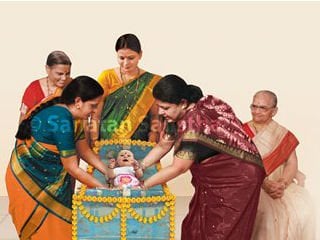 Namakaran (Naming ceremony)
Namakaran (Naming ceremony)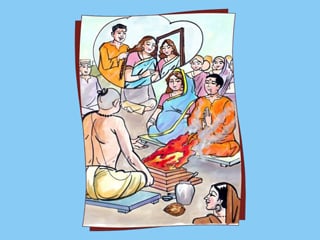 Simantonnayan (Parting the wife’s hair) -Third sanskar
Simantonnayan (Parting the wife’s hair) -Third sanskar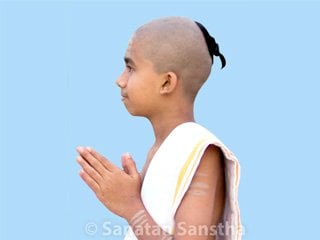 Choulkarma (Chudakarma) – keeping a shendi !
Choulkarma (Chudakarma) – keeping a shendi !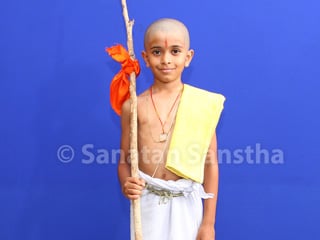 Upanayan (Vratabandha, Munja) – Ninth Sanskar
Upanayan (Vratabandha, Munja) – Ninth Sanskar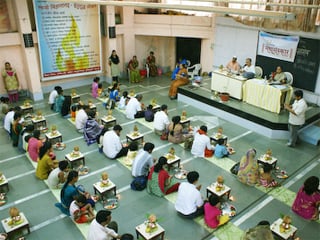 Medhajanan (Palsola vidhi)
Medhajanan (Palsola vidhi)